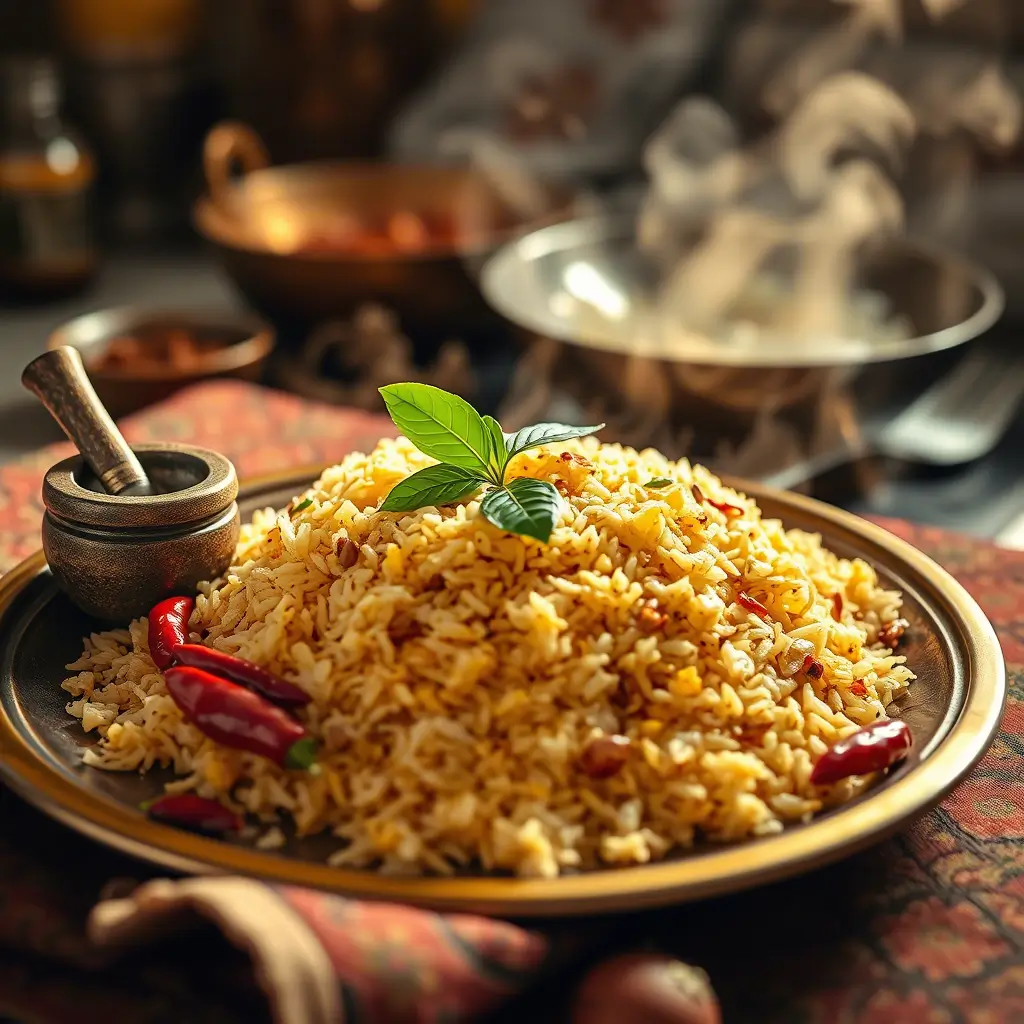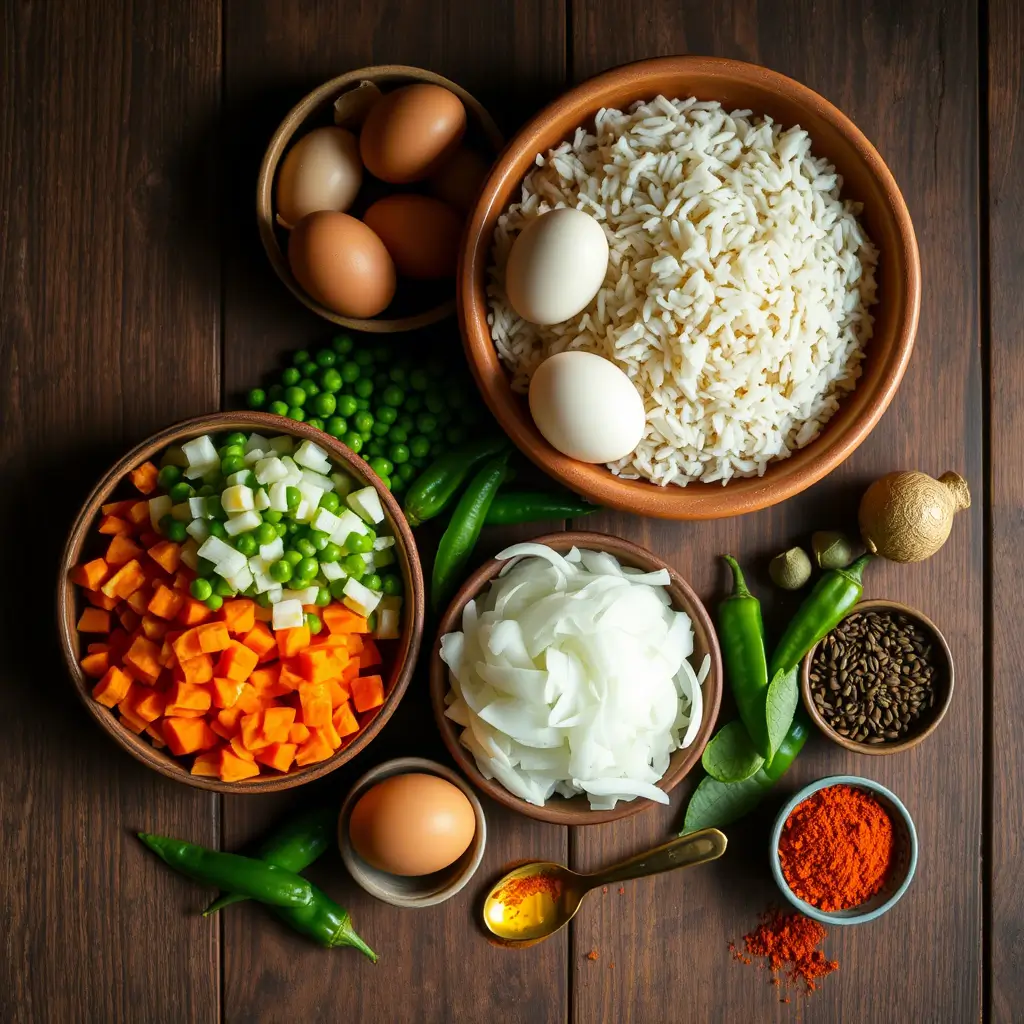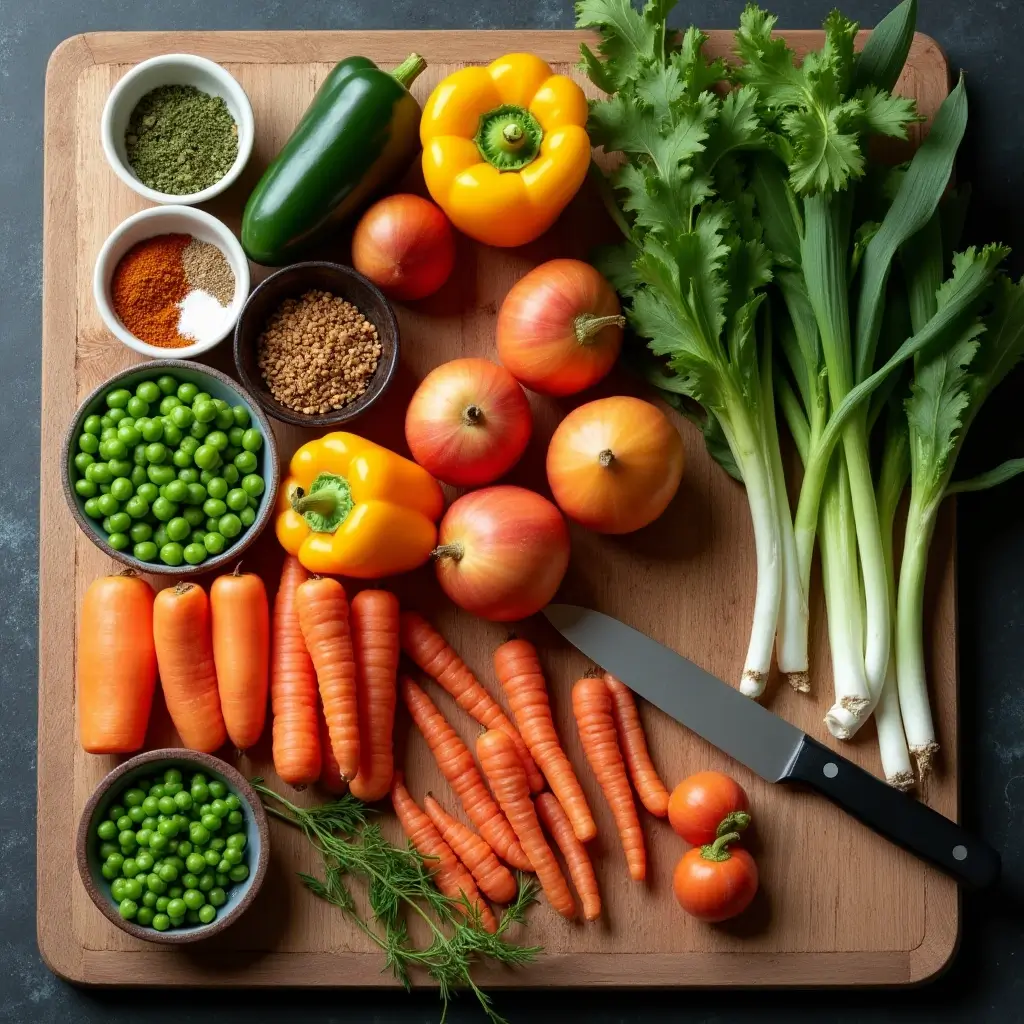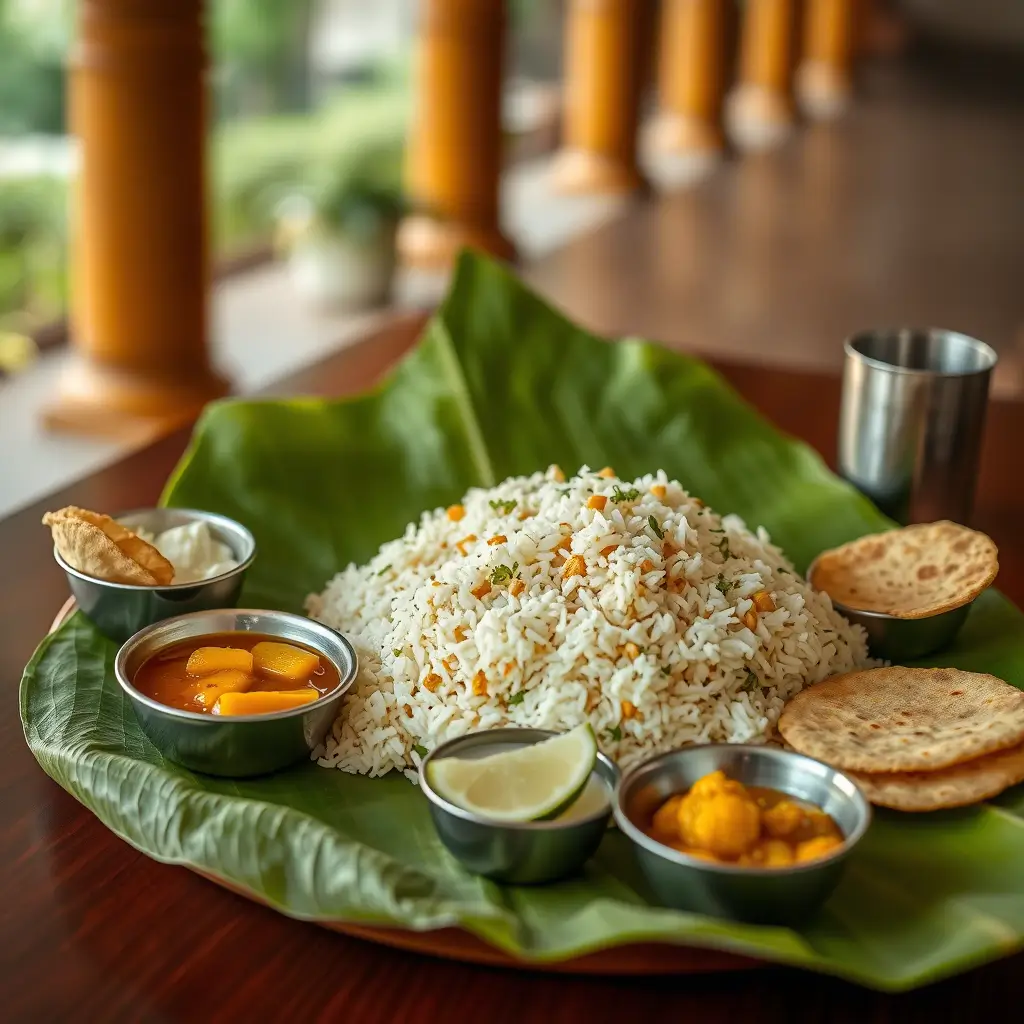Key Takeaways:
- Learn how to make authentic Anjappar egg fried rice at home.
- Discover the secret ingredients and techniques used in restaurants.
- Find out how to get perfectly fluffy and flavorful fried rice every time.
- Get expert tips on ingredient selection, cooking methods, and variations.
- Learn how to store and reheat your fried rice without losing flavor or texture.
Table of contents
- Introduction :
- History of Anjappar Restaurant
- Understanding Chettinad Cuisine
- Essential Ingredients for Authentic Anjappar Egg Fried Rice
- Preparing the Perfect Rice
- Mastering the Egg Component
- Vegetable Selection and Preparation
- Cooking Equipment Essentials
- Step-by-Step Cooking Instructions
- Common Mistakes to Avoid
- Variations and Customizations
- Serving Suggestions
- Storage and Reheating Tips
- Health Considerations
- Frequently Asked Questions (FAQs)
- Conclusion
Introduction:
Anjappar is a well-known South Indian restaurant famous for its rich Chettinad flavors. One of its most loved dishes is the Anjappar egg fried rice. This dish is a fusion of Chinese cooking techniques and Indian spices, making it both flavorful and unique.
Egg fried rice is a staple in many Asian cuisines, but Anjappar’s version stands out due to its distinct South Indian twist. It perfectly balances the smoky, umami-rich flavors of traditional fried rice with the aromatic spices of Chettinad cuisine. The dish is a delightful combination of fluffy, non-sticky rice, soft scrambled eggs, and a flavorful mix of seasonings that create a burst of taste in every bite.
One of the key factors that make this dish special is the selection of spices and cooking techniques. Unlike regular Chinese-style fried rice, Anjappar egg fried rice incorporates ingredients like curry leaves, black pepper, fennel seeds, and green chilies, which enhance its bold and aromatic profile. The secret lies in the perfect balance of heat, spices, and texture.
In this guide, you’ll learn how to recreate this famous dish at home, ensuring that you get the same authentic taste as served in Anjappar restaurants. From choosing the right type of rice to mastering the wok-frying method, we’ll cover everything step by step.
By the end of this article, you’ll know exactly how to make restaurant-style Anjappar egg fried rice, what ingredients to use, and how to achieve that perfect balance of flavors. Whether you’re cooking for yourself or impressing guests, this dish is guaranteed to be a hit!
So, let’s dive into the journey of making this delicious and flavorful fried rice right in your kitchen.
History of Anjappar Restaurant
Anjappar started in Chennai, India, more than 50 years ago. It quickly became famous for its authentic Chettinad cuisine. Over time, Anjappar expanded globally, bringing South Indian flavors to food lovers worldwide.
Chettinad food is known for its bold spices, and Anjappar mastered the art of combining these flavors with Chinese-style fried rice techniques. This fusion is what makes their egg fried rice so special.
Understanding Chettinad Cuisine
Chettinad cuisine is famous for its rich, aromatic spices and bold flavors. It uses a lot of ingredients like:
- Fennel seeds Adds a sweet, mild licorice-like flavor.
- Curry leaves Enhances the aroma and provides an earthy taste.
- Black pepper Gives a mild heat without overpowering the dish.
- Star anise and cinnamon Used in small amounts to add warmth and depth.
Unlike traditional Chinese fried rice, Anjappar’s version includes Indian spices, making it a unique and flavorful dish.
Essential Ingredients for Authentic Anjappar Egg Fried Rice

To achieve the authentic taste of Anjappar egg fried rice, it’s crucial to use the right ingredients. Each ingredient plays an important role in enhancing the flavor and texture of the dish. Here’s a detailed breakdown of the key components:
1. Rice – The Foundation of the Dish
The type of rice you use is essential to get the perfect fried rice texture. The best choice is:
- Basmati rice This long-grain rice remains separate and fluffy after cooking, making it perfect for fried rice.
- Day-old cooked rice Using rice that has been cooked and refrigerated overnight helps reduce moisture and prevents it from becoming mushy.
- Parboiled rice (optional) Some chefs prefer parboiled rice for its firm texture, which holds up well when stir-fried.
2. Eggs – The Star Protein
Eggs add richness and texture to the dish. They should be:
- Beaten and lightly seasoned before cooking to ensure a uniform taste.
- Cooked separately first, then added back into the rice for an even distribution of flavor.
- Scrambled until soft and fluffy, avoiding overcooking, which can make them rubbery.
3. Oil and Fat – Enhancing the Flavors
Using the right type of oil enhances the taste and prevents the rice from sticking. The best choices include:
- Sesame oil Adds a nutty aroma and enhances the umami taste.
- Peanut oil Common in South Indian cooking, giving a mild roasted flavor.
- Ghee (optional) Adds richness and depth to the dish.
4. Aromatics – The Base of Flavor
Aromatics provide the foundation of taste in Anjappar egg fried rice. Essential ingredients include:
- Garlic and ginger Finely chopped or minced for maximum flavor.
- Green chilies Adds a slight heat and freshness to the dish.
- Spring onions Used both for cooking and garnishing.
5. Spices and Seasonings – The Secret to Authentic Flavor
Anjappar egg fried rice stands out due to its unique blend of spices. These include:
- Black pepper Provides heat and depth of flavor.
- Fennel seeds Adds a mild sweetness and enhances aroma.
- Curry leaves Gives a signature South Indian touch.
- Soy sauce Balances umami flavors and enhances color.
- Salt and white pepper Essential for seasoning.
6. Vegetables – Adding Color and Crunch
While not always included, vegetables can add texture and nutritional value. Common choices are:
- Carrots, bell peppers, and cabbage Finely chopped for even cooking.
- Green peas Adds sweetness and color.
7. Additional Enhancers – The Finishing Touches
To give the dish an authentic restaurant-style taste, consider adding:
- Ajinomoto (MSG) (optional) Enhances umami flavor.
- Rice vinegar or lemon juice Adds a subtle tanginess.
- Chili sauce or green chili paste For an extra spicy kick.
How These Ingredients Work Together
Each ingredient in Anjappar egg fried rice has a purpose, contributing to the final flavor and texture:
- Rice provides the foundation.
- Eggs add richness and protein.
- Oil ensures a non-sticky texture.
- Aromatics and spices create depth and authenticity.
- Vegetables and additional enhancers round out the flavor.
By carefully selecting and balancing these ingredients, you can achieve the same restaurant-style taste at home!
Preparing the Perfect Rice

Why Use Day-Old Rice?
- Freshly cooked rice contains too much moisture, making it sticky when fried.
- Day-old rice is firmer and drier, allowing each grain to stay separate while stir-frying.
Step-by-Step Guide to Cooking and Storing Rice
- Rinse the Rice Wash the rice under cold water until the water runs clear to remove excess starch.
- Cook the Rice Use a rice cooker or a large pot. The ideal water-to-rice ratio is 1:1.5.
- Cool the Rice Spread the cooked rice on a tray and let it cool completely before refrigerating.
- Store Properly Place the rice in an airtight container and refrigerate for at least 8 hours.
- Before Cooking Let the rice sit at room temperature for 10 minutes and fluff it with a fork.
Mastering the Egg Component
Scrambling Eggs the Right Way
- Beat the eggs well with a pinch of salt and pepper before cooking.
- Use a non-stick pan or wok to prevent sticking.
- Cook over medium heat to avoid overcooking.
- Stir gently to create soft, fluffy curds rather than large chunks.
Timing and Temperature Considerations
- Cook eggs separately first This prevents them from getting overcooked when mixed with rice.
- Use moderate heat High heat can make eggs rubbery, while low heat might make them watery.
- Add eggs back at the end This helps maintain their softness.
Vegetable Selection and Preparation

Choosing the Right Vegetables
- Carrots Adds sweetness and color.
- Bell peppers Enhances crunch and flavor.
- Cabbage Adds texture and balances flavors.
- Green peas Provides a mild sweetness.
Preparation Methods
- Chop vegetables finely for even cooking.
- Stir-fry quickly over high heat to retain crispness.
- Avoid overcooking – Vegetables should remain slightly crunchy.
Cooking Equipment Essentials
Essential Kitchen Tools
- Wok or large skillet Provides even heat distribution and enhances the smoky flavor.
- Spatula Helps stir-fry efficiently without breaking the rice.
- Mixing bowls Useful for prepping ingredients before cooking.
- Rice cooker or large pot Ensures perfectly cooked rice.
Optional Tools for Better Cooking
- Non-stick pan Useful for scrambling eggs.
- Measuring spoons/cups Helps maintain consistency in seasoning.
Step-by-Step Cooking Instructions
Experience the vibrant flavors of Chettinad cuisine with this aromatic, spicy egg fried rice, inspired by the renowned Anjappar restaurants.
Ingredients (Serves 4)
Prepare these ingredients in advance for seamless cooking:
- Rice: 1.5 cups basmati rice (or day-old rice for better texture)
- Eggs: 4 large eggs, lightly beaten
- Vegetables: 1 onion (finely chopped), 1 carrot (diced), 1/2 cup green beans (chopped), 1/4 cup frozen peas
- Aromatics: 2 green chilies (slit), 1 tbsp ginger-garlic paste, 1 sprig curry leaves
- Spices: 1 tsp cumin seeds, 1 tsp fennel seeds, 1/2 tsp turmeric, 1 tsp red chili powder, 1/2 tsp garam masala
- Oil: 3 tbsp sesame oil or gingelly oil (traditional for depth)
- Seasoning: Salt to taste, 1 tbsp lemon juice, fresh cilantro (garnish)
Preparing Ingredients (15 minutes)
a. Rice Prep:
- Rinse basmati rice under cold water until it runs clear. Soak for 20 minutes, then drain.
- Tip: Soaking ensures fluffy grains; skip if using day-old rice.
b. Vegetable Prep:
- Dice carrots, beans, and onions uniformly for even cooking.
- Thaw peas and keep all veggies accessible.
c. Aromatics & Spices:
- Slit green chilies, prepare ginger-garlic paste, and measure spices into small bowls.
Cooking the Rice (20 minutes)
- In a pot, boil 3 cups of water. Add drained rice, 1 tsp oil, and a pinch of salt.
- Cook on low heat for 15–18 minutes until tender. Fluff with a fork.
- Spread rice on a tray to cool. Critical step: Cooling prevents mushiness during stir-frying.
Scrambling the Eggs (5 minutes)
- Heat 1 tbsp oil in a pan. Pour beaten eggs, stirring gently.
- Cook until softly set (avoid overcooking). Transfer to a plate.
Stir-Frying Vegetables & Spices (10 minutes)
- Tempering: Heat 2 tbsp oil. Add cumin, fennel, and curry leaves. Sizzle for 30 seconds.
- Aromatics: Add onions, green chilies, and ginger-garlic paste. Sauté until golden.
- Vegetables: Toss in carrots, beans, and peas. Stir-fry on high heat for 3–4 minutes.
- Spices: Sprinkle turmeric, red chili powder, and salt. Mix well.
Combining All Components (7 minutes)
- Add cooled rice to the veggie mix. Gently fold to avoid breaking grains.
- Stir in scrambled eggs and garam masala.
- Drizzle lemon juice. Toss on high heat for 2 minutes to meld flavors.
Final Seasoning & Serving Suggestions
- Taste Test: Adjust salt and spice. Add a pinch of sugar if needed.
- Garnish: Fresh cilantro and a lemon wedge.
- Serve Hot: Pair with cucumber raita, mango pickle, or papadum.
Common Mistakes to Avoid
Using Freshly Cooked Rice
- Fresh rice is too moist and can become sticky.
- Solution: Use day-old rice that has been refrigerated for at least 8 hours.
Overloading the Wok
- Adding too many ingredients at once lowers the temperature and causes steaming instead of frying.
- Solution: Cook in batches to maintain high heat and achieve a smoky flavor.
Incorrect Heat Levels
- Low heat results in soggy rice.
- Solution: Use high heat to quickly fry the rice and develop a light, crispy texture.
Neglecting Essential Spices
- Omitting key spices can make the dish bland.
- Solution: Always include black pepper, fennel seeds, and curry leaves for authentic flavor.
Variations and Customizations
Want to put your own spin on this dish? Here are some easy ways to customize your Anjappar egg fried rice:
Adding Proteins
Enhance the dish by including additional proteins:
- Chicken – Marinate in light soy sauce and stir-fry before adding.
- Shrimp – Cooks quickly and adds a seafood twist.
- Tofu – A great vegetarian option; pan-fry for a crispy texture.
Incorporating Different Vegetables
Mix and match vegetables for added nutrition and flavor:
- Mushrooms – Adds umami depth.
- Capsicum (Bell Peppers) – Adds crunch and color.
- Broccoli or Baby Corn – Provides extra texture and taste.
Adjusting Spice Levels
Make the dish milder or spicier to suit your taste:
- For more heat – Add extra green chilies or chili sauce.
- For a milder taste – Reduce pepper and chilies.
- For a tangy twist – Add more lemon juice or vinegar.
Serving Suggestions
Pair Anjappar egg fried rice with complementary side dishes for a complete meal:
- Raita A cooling yogurt based side that balances the spices.
- Papadums Crispy and light, adding a crunchy texture.
- Vegetable curry A flavorful accompaniment that pairs well with the rice.
Storage and Reheating Tips
To keep leftovers fresh:
- Cooling before storing – Let the rice cool completely before refrigerating to prevent moisture buildup.
- Refrigeration – Store in an airtight container for up to 2 days.
- Freezing – Freeze in portion sized bags for up to a month.
Reheating:
- Microwave – Sprinkle water over the rice and heat for 1-2 minutes.
- Stovetop – Reheat in a pan with a bit of oil to restore texture
Health Considerations
Make a healthier version by:
- Using brown rice More fiber and nutrients.
- Reducing oil or ghee Lowers calorie content.
- Adding more vegetables Enhances nutrition without compromising flavor.
Frequently Asked Questions (FAQs)
What is the secret ingredient to restaurant fried rice?
The secret ingredient is high heat and wok hei (the smoky, charred aroma achieved from stir-frying). Additionally, MSG or chicken powder is often used to enhance umami flavor.
What makes fried rice taste authentic?
Using day-old rice, high heat, proper seasoning (like soy sauce and sesame oil), and fresh aromatics (garlic, ginger, green onions) ensures authentic flavor.
What is the difference between Japanese and Chinese fried rice?
Japanese fried rice uses short-grain rice, while Chinese fried rice is made with long-grain or jasmine rice for a fluffier texture. Japanese fried rice often includes soy sauce and mirin, whereas Chinese versions use oyster sauce, soy sauce, and sometimes MSG.
What is the use of vinegar in fried rice?
Vinegar adds a slight tang and helps balance flavors. It also helps break down excess starch, making the rice less sticky.
Do Chinese restaurants use butter in fried rice?
Most Chinese restaurants use oil (vegetable or peanut oil), but some places use butter for added richness, especially in hibachi-style fried rice.
What is the secret to dry fried rice?
Using cold, day-old rice prevents mushiness. Cooking on high heat and stirring frequently also helps keep it dry.
Why does Chinese restaurant fried rice taste so good?
Restaurants use MSG, high heat, seasoned woks, and fresh ingredients to enhance flavor.
What are the ingredients in traditional Chinese fried rice?
Traditional ingredients include rice, eggs, soy sauce, sesame oil, garlic, green onions, and a protein like chicken, shrimp,
Should I use mirin in fried rice?
Mirin is more common in Japanese cooking. For Chinese-style fried rice, soy sauce, oyster sauce, or Shaoxing wine are better choices.
Is fried rice and egg fried rice the same?
No. Egg fried rice is a simpler version with just eggs, rice, and basic seasonings, while fried rice can include meat, vegetables, and extra seasonings.
Why is Japanese fried rice so good?
Japanese fried rice is lightly seasoned, cooked on a teppanyaki grill, and often includes butter for a rich, savory taste.
What is the difference between fried rice and yang chow fried rice?
Yang Chow fried rice is a Cantonese-style dish that typically includes char siu (BBQ pork), shrimp, and green peas, making it more flavorful than regular fried rice.
What is the secret to a good fried rice?
The key is high heat, dry rice, minimal moisture, and constant stirring to prevent clumping.
Why add vinegar to rice?
Vinegar helps enhance flavors and prevent stickiness.
What to add to fried rice for flavor?
Try adding soy sauce, oyster sauce, garlic, ginger, sesame oil, green onions, and black pepper.
What gives Chinese fried rice its flavor?
A combination of soy sauce, sesame oil, garlic, and umami-rich seasonings.
Is oyster sauce necessary for fried rice?
No, but it adds depth and umami flavor. If unavailable, substitute with soy sauce or hoisin sauce.
Why sesame oil in fried rice?
Sesame oil adds a nutty, aromatic flavor that enhances the dish.
How do you keep fried rice fluffy?
Use cold, day-old rice, cook on high heat, and avoid adding too much liquid.
What is fried rice syndrome?
This refers to food poisoning from Bacillus cereus, a bacteria that grows on improperly stored rice. Always refrigerate rice within 2 hours.
What makes fried rice crunchy?
Cooking at high heat with minimal oil can add a slight crunch. Some people like to fry the rice longer for a crispy texture.
Should I put rice vinegar in my fried rice?
A little rice vinegar can enhance the flavor, but it’s optional.
What is the flavor enhancer in fried rice?
MSG, chicken powder, or a mix of soy sauce, oyster sauce, and black pepper enhance the flavor.
What is the difference between fried rice and Chinese fried rice?
Chinese fried rice is usually seasoned with soy sauce and aromatics, while other fried rice varieties (like Thai or Indonesian) may include fish sauce, basil, or sambal for different flavor profile
Conclusion
Now you know how to make authentic Anjappar egg fried rice at home! Try it today and impress your family with this delicious dish. Let us know how it turns out in the comments!

